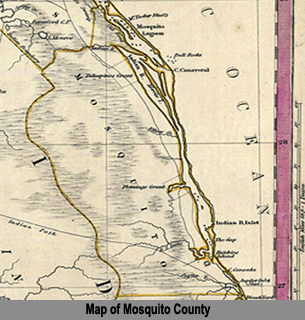
Orange and Osceola counties, which today make up the Ninth Judicial Circuit, were once part of a large tract of land below St. Johns County that in 1824, was dubbed Mosquito County. It was well named, as the misery of those early circuit riders attests, and had a population of fewer than 1,000 people in an area that occupied much of Central Florida.
In a burst of civic and entrepreneurial forethought worthy of their modern-day counterparts, Florida’s founding fathers changed the name to the more esthetically pleasing Orange County when Florida became a state in 1845. Osceola County was carved out of portions of Orange and Brevard Counties in 1887.
The number of circuits in the state, along with the counties assigned to the circuits have, more or less steadily increased since statehood, but there was certainly some juggling and adding and subtracting during the years. Orange and Osceola counties have been part of several different circuits since Territorial days.
Florida went from two to four judicial circuits upon statehood and then was divided into seven by the Constitution of 1868. Orange County was placed in the Seventh. An amendment in 1870 reduced the number of circuits to five, and Orange County was assigned, for a while, to the Fifth Circuit. The Constitution of 1885 bumped the number back up to seven, putting Orange County back into the Seventh Circuit, along with Osceola County, which was created in 1887, where they remained until 1919.
Early circuit judges from this area included John D. Broom, of DeLand, commissioned and confirmed by the Senate in 1887 for six years, and again in 1893; Minor S. Jones, of Titusville, commissioned in 1898 and again in 1899 and 1905; and James W. Perkins, of DeLand, commissioned in 1911 and again in 1917. In 1899 there were approximately 300 judges and lawyers in all of Florida.
In 1919, Orange and Osceola Counties became part of a specially created Seventeenth Circuit, where they remained until 1935. Judges from this era include Charles O. Andrews, of Orlando, commissioned in 1919 for four years, and in 1926 for six years, resigned in 1925; Frank A. Smith, of Orlando, commissioned in 1925 and again in 1929 for six years.
![]()
The two counties were placed in the Ninth Judicial Circuit in 1935, along with Brevard, Indian River, Martin, Orange, Osceola, Okeechobee, St. Lucie and Seminole counties. In 1973, the legislature whittled and reassigned the number of counties that made up the Ninth, and it was reorganized once again into its present configuration of Orange and Osceola counties.
The annual salary of a Circuit Judge in 1865 was $2,500, and in 1866 it was raised to $3,000. The Constitution of 1868 set the salaries at $3,500. The judges took a big hit in 1885, when budget constraints moved legislators to make deep cuts, and the annual income mentioned in the Constitution was reduced to $2,500; but by 1902, an Amendment raised that to $2,750. In 1927 the annual income was $7,500; in 1974, $36,000; in the mid 80s it rose to about $78,000.